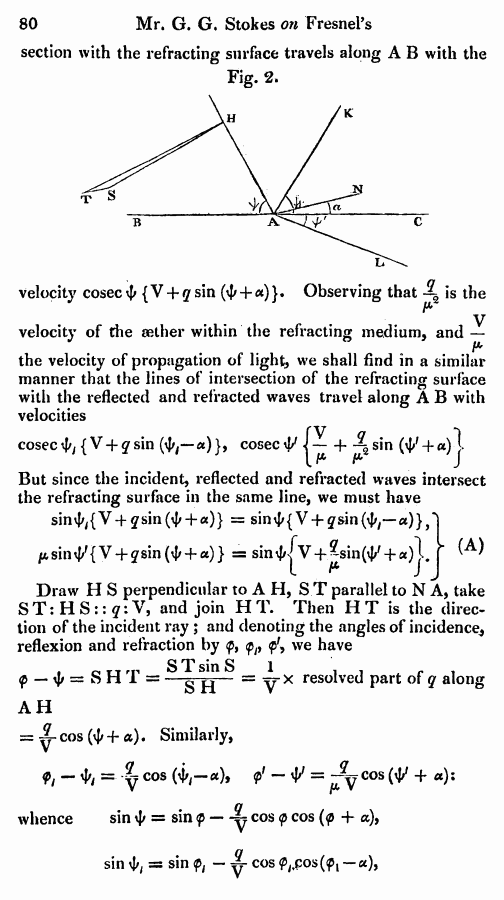

Theory of,the Aberration of Light.
79
Draw Gg, HA perpendicular to the plane P, and in the direction of the resolved part p of the velocity of the aether, and
Fig. 1.
F/ifl thft opposit# directidh; and take
F/: HA:F and Gg = Ff,
adjoin A with f9 g and //. Then/A, Ag, Ah will be the directions of the incident, reflected and refracted rays. Draw F D*_ H E perpendicular to D E, and join /D, AE. Then jfD^F, A EH will be the inclinations of the planes /AD, & A E to the plane P. Now
sin FAD = sin HAE; therefore tanFDy’ = tanHEA, atid therefore the refracted ray A h lies in the plane of incidence /AD. It is easy to see that the same is true of the rejected ray A#. Also ZgAP=/AD; and the angles /AD, h A E are sensibly equal toFAD, HAE respectively, And tve therefore have without sensible error, sin/AI) = ft sin h A E. Hence the laws of reflexion and refraction are not sensibly affected by the velocity^?.
Let us now consider the effect of the velocity q. As far as depends on this velocity, the incident, reflected and refracted rays will all be in the plane P. Let A H, A K, A L be the intersections of the plane P with the incident, reflected and refracted waves. Let rj/,, be the inclinations of these waves to the refracting surface ; let N A be the direction of the resolved part q of the velocity of the aether, and let the angle N A C = u.
The resolved part of q in a direction perpendicular to A H is q sin (\J/ + a). Hence the wave A H travels with the velocity V + q sin (ty 4 a); and consequently the line of its inter
tan H E h =
P
ju,-1 V sin H A E*
80 Mr. G. G. Stokes on FresnePs
section with the refracting surface travels along A B with the
Fig. 2.
Velocity cosec ^ {V + gsin + Observing that \ |s the
velocity of the aether within the refracting medium, and —
the velocity of propagation of light, we shall find in a similar manner that the lines of intersection of the refracting surface with the reflected and refracted waves travel along A B with velocities
cosec
4/, { V + q sin (fy— a) }, cosec V {— + \ sin (<|/ + «)").
L f* f* J
But since the incident, reflected and refracted waves intersect the refracting surface in the same line, we must have shnJ/j{V + 5,sin(4' + a)} = sintJ^V + gsinty,—«)}/
/<,sin4/{V + jsin(4' + «)} = sin\J/jv +-sin(>J/ + a)l
I ** J
(A)
Draw H S perpendicular to A H, S T parallel to N A, take S T: H S:: <7: V, and join H T. Then H T is the direction of the incident ray; and denoting the angles of incidence, reflexion and refraction by <p, <p,, <?', we have
<p — ij/ = S H T = ^ resolved part of q along
AH
= 3-. cos (4< + «)• Similarly,
ft — 'J'/ = y cos (fy—*)» <p' — ty = ^cos (i{/ + a) i whence sin \J/ = sin <p —^ cos <p cos (<p + a), sin ^ = sin <p, - y cos ^,pos(f, - a),